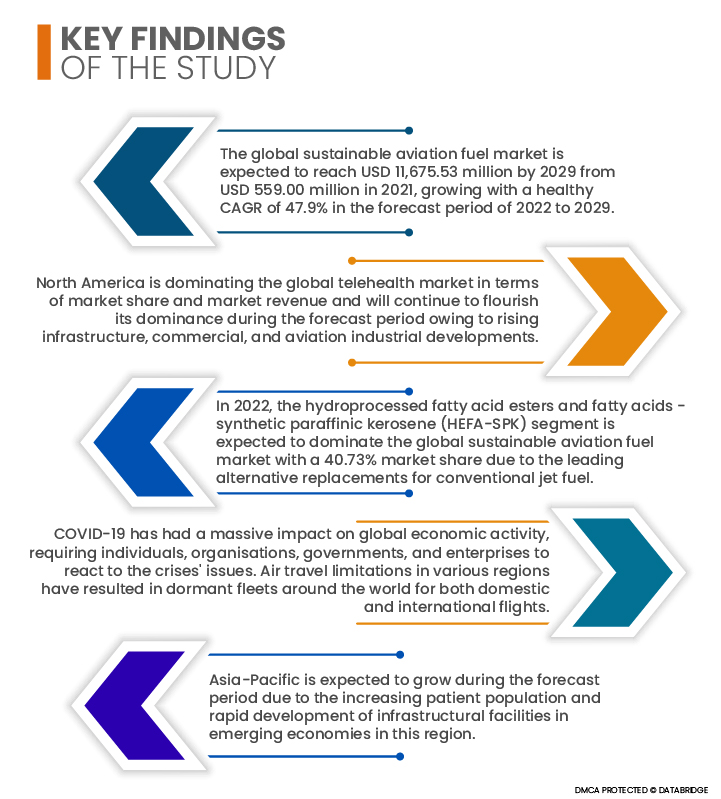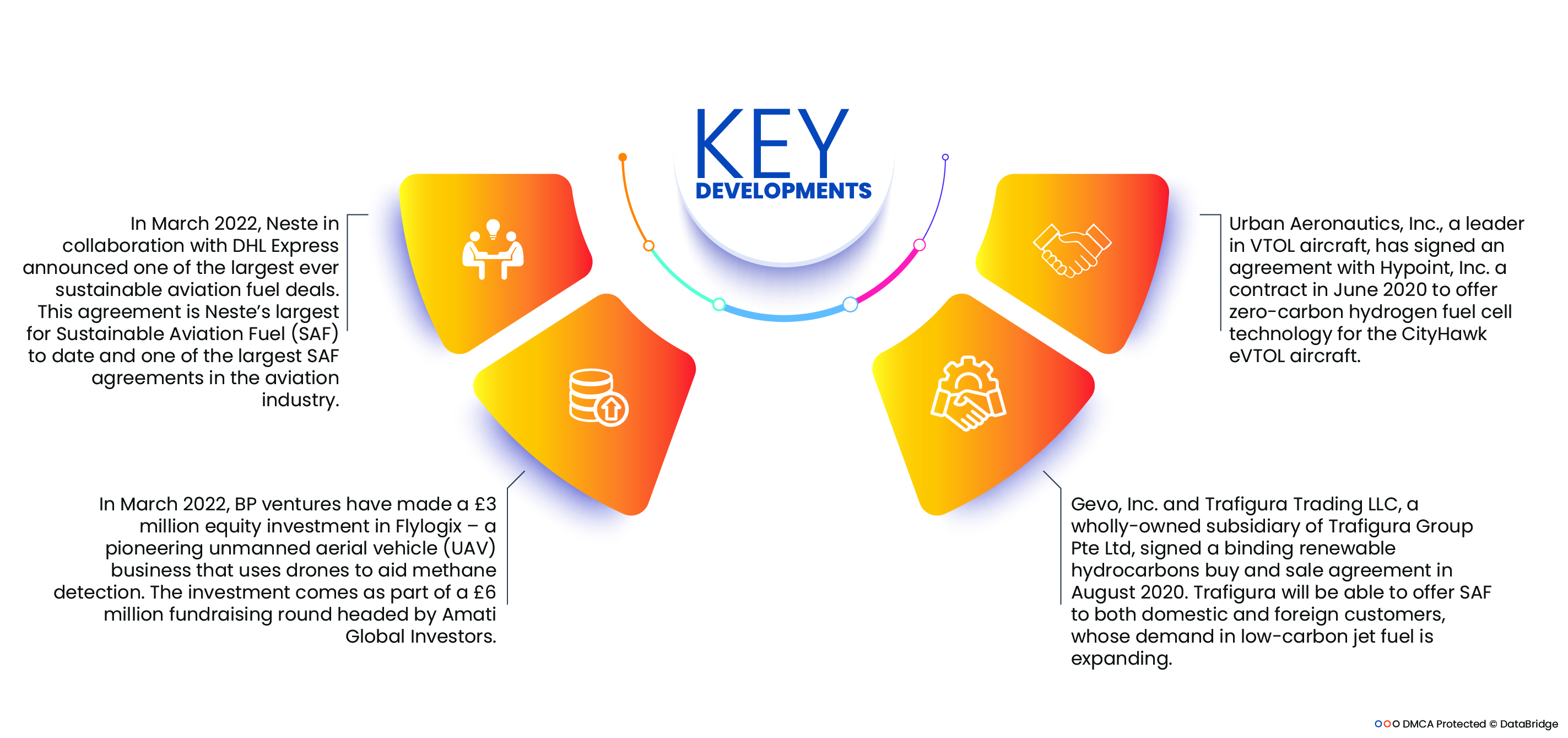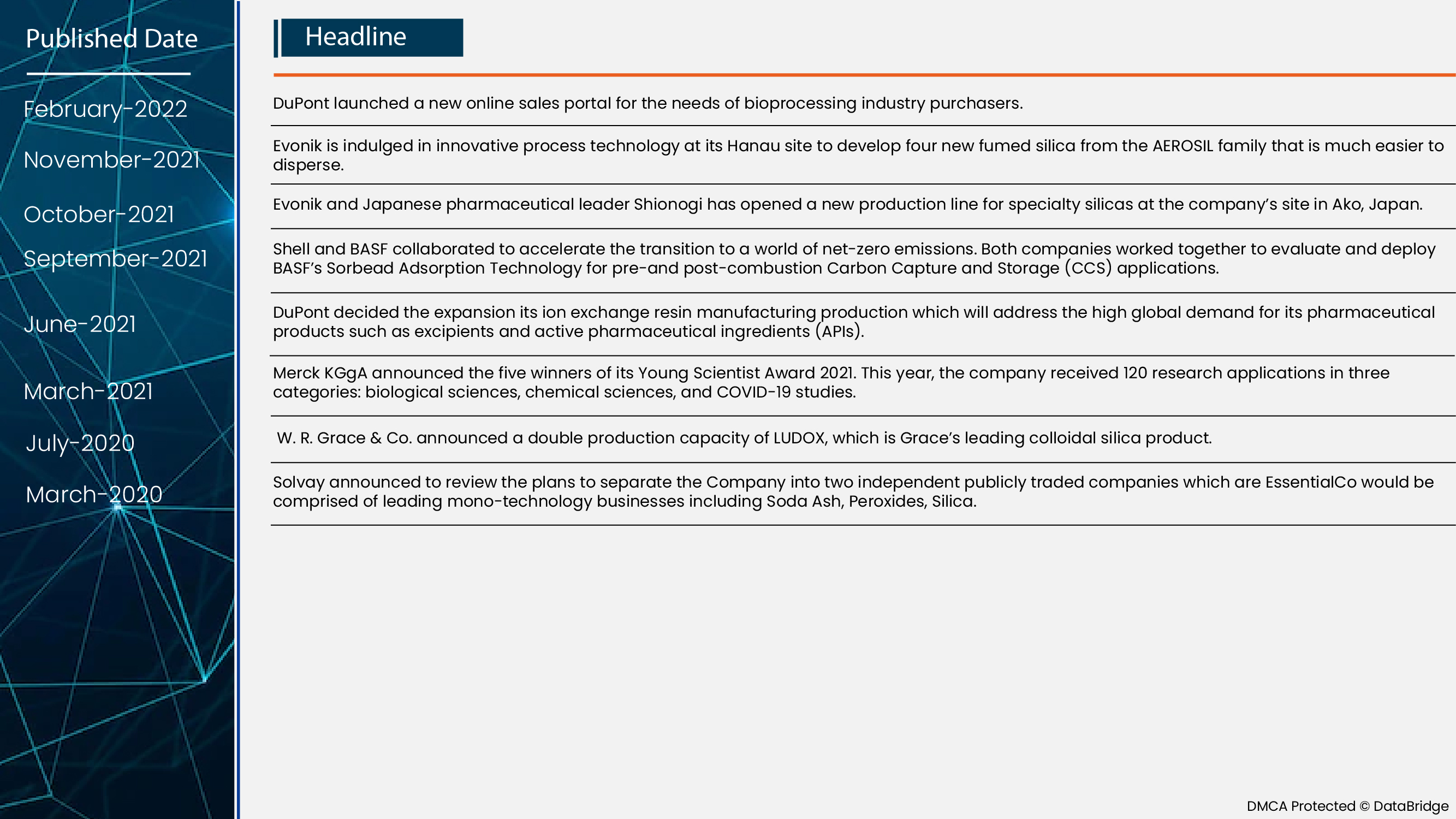Применение устойчивого авиационного топлива является шагом к сохранению окружающей среды. Устойчивое авиационное топливо помогает окружающей среде, сокращая выбросы углекислого газа. Это, в свою очередь, приведет к уменьшению вклада в глобальное потепление. Устойчивое авиационное топливо является уникальной формой топлива, разработанной для использования в самолетах, и в то же время повышает производительность самолетов. Оно производится из устойчивого сырья и может быть весьма сопоставимо по своему химическому составу со стандартным ископаемым реактивным топливом.
Доступ к полному отчету по адресу https://www.databridgemarketresearch.com/reports/global-sustainable-aviation-fuel-market
Ожидается, что глобальный рынок устойчивого авиационного топлива достигнет 11 675,53 млн долларов США к 2029 году с 559,00 млн долларов США в 2021 году, увеличившись со здоровым среднегодовым темпом роста в 47,9% в прогнозируемый период с 2022 по 2029 год. Такие факторы, как рост числа пассажиров авиалиний, рост располагаемого дохода, рост авиаперевозок и рост потребления синтетических смазочных материалов, дополняют рост глобального рынка устойчивого авиационного топлива. Рост и расширение авиационной промышленности также будут способствовать росту рынка. Однако отсутствие инфраструктуры выступает в качестве сдерживающего фактора для рынка.

Ожидается , что рост объемов авиаперевозок и потребления синтетических смазочных материалов будет способствовать росту рынка.
Рост числа пассажиров, путешествующих воздушным транспортом, стимулирует темпы роста рынка. Воздушные перевозки являются важнейшим компонентом в достижении экономического роста и развития. Они способствуют росту торговли, туризма и возможностей трудоустройства. Авиационная система развивается и будет продолжать развиваться. Это, в свою очередь, будет выступать в качестве важного фактора, определяющего рост рынка. Увеличение расходов государственных и частных игроков на развитие авиационной инфраструктуры также будет способствовать темпам роста рынка. Постоянные исследования и разработки, касающиеся внедрения передовых технологий, снова расширят масштабы роста. Однако системе воздушного транспорта будет сложно достаточно быстро адаптироваться для удовлетворения меняющихся потребностей в долгосрочной перспективе.
Область отчета и сегментация рынка
Отчет Метрика
|
Подробности
|
Прогнозируемый период
|
2022-2029
|
Базовый год
|
2021
|
Исторические годы
|
2020 (Можно настроить на 2018 - 2013)
|
Количественные единицы
|
Доход в млн. долл. США, объемы в единицах, цены в долл. США
|
Охваченные сегменты
|
Тип топлива (биотопливо, водородное топливо и энергия в жидкое топливо ), технология производства (гидроочищенные эфиры жирных кислот и жирные кислоты - синтетический парафиновый керосин (HEFA-SPK), синтетический парафиновый керосин Фишера-Тропша (FT-SPK), синтетический изопарафин из ферментированного гидроочищенного сахара (HFS-SIP), синтетический парафиновый керосин Фишера-Тропша (FT) с ароматикой (FT-SPK/A), спирт для реактивного двигателя SPK (ATJ-SPK) и реактивный двигатель каталитического гидротермолиза (CHJ)), смешивающая способность (ниже 30%, от 30% до 50% и выше 50%), платформа смешивания (коммерческая авиация, военная авиация, деловая и общая авиация, а также беспилотные летательные аппараты)
|
Страны, охваченные
|
США, Канада и Мексика в Северной Америке, Германия, Франция, Великобритания, Нидерланды, Швейцария, Бельгия, Россия, Италия, Испания, Турция, Остальная Европа в Европе, Китай, Япония, Индия, Южная Корея, Сингапур, Малайзия, Австралия, Таиланд, Индонезия, Филиппины, Остальная часть Азиатско-Тихоокеанского региона (APAC) в Азиатско-Тихоокеанском регионе (APAC), Саудовская Аравия, ОАЭ, Южная Африка, Египет, Израиль, Остальной Ближний Восток и Африка (MEA) как часть Ближнего Востока и Африки (MEA), Бразилия, Аргентина и Остальная часть Южной Америки как часть Южной Америки.
|
Охваченные участники рынка
|
Neste (Финляндия), Gevo (США), VELOCYS (Великобритания), Fulcrum BioEnergy (США), SkyNRG (Нидерланды), Prometheus Fuels (США), World Energy (США), Avfuel Corporation (США), LanzaTech (США), Preem AB (Швеция), Eni (Италия), Sasol Ltd (Южная Африка), BP plc (Великобритания), Cepsa (Испания), Honeywell International Inc (США), Chevron Corporation (США), TotalEnergies (Франция), Exxon Mobil Corporation (США), Johnson Matthey (Великобритания), VIRENT, INC. (США), HyPoint Inc. (США), ZeroAvia, Inc. (США) и другие
|
Данные, отраженные в отчете
|
Помимо таких рыночных данных, как рыночная стоимость, темпы роста, сегменты рынка, географический охват, участники рынка и рыночный сценарий, рыночный отчет, подготовленный командой Data Bridge Market Research, также включает в себя углубленный экспертный анализ, анализ импорта/экспорта, анализ цен, анализ потребления продукции и анализ пестицидов.
|
Анализ сегмента:
Глобальный рынок экологически чистого авиационного топлива делится на четыре основных сегмента в зависимости от типа топлива, технологии производства, мощности смешивания и платформы смешивания.
- Глобальный рынок устойчивого авиационного топлива сегментирован на биотопливо, водородное топливо и электрическую энергию в жидкое топливо в зависимости от типа топлива. Ожидается, что в 2022 году сегмент биотоплива будет доминировать на мировом рынке устойчивого авиационного топлива с долей рынка 82,79% из-за быстрого развития технологических путей коммерциализации использования альтернативного реактивного топлива.
Ожидается, что биотопливо станет доминирующим сегментом типа топлива на мировом рынке устойчивого авиационного топлива.
В 2022 году биотопливо будет доминировать в сегменте видов топлива из-за растущих технологических достижений, относящихся к производственным машинам. Кроме того, быстрое развитие технологических путей коммерциализации использования альтернативного реактивного топлива в сочетании с растущим вниманием к целям устойчивого развития расширит возможности роста этого сегмента.
- На основе технологии производства глобальный рынок устойчивого авиационного топлива сегментирован на гидроочищенные эфиры жирных кислот и жирные кислоты - синтетический парафиновый керосин (hefa-spk), синтетический парафиновый керосин Фишера-Тропша (FT-SPK), синтетический изопарафин из ферментированного гидроочищенного сахара (hfs-sip), синтетический парафиновый керосин Фишера-Тропша (ft) с ароматикой (ft-spk/a), спирт для реактивного spk (atj-spk) и каталитический гидротермолизный реактивный (CHJ). Ожидается, что в 2022 году сегмент гидроочищенных эфиров жирных кислот и жирных кислот - синтетический парафиновый керосин (HEFA-SPK) будет доминировать на мировом рынке устойчивого авиационного топлива с долей рынка 40,73% за счет ведущих альтернативных замен традиционного реактивного топлива.
- На основе емкости смешивания глобальный рынок устойчивого авиационного топлива был сегментирован на менее 30%, от 30% до 50% и более 50%. Ожидается, что в 2022 году сегмент ниже 30% будет доминировать на мировом рынке устойчивого авиационного топлива с долей рынка 74,0%, поскольку умеренная емкость смешивания, возможность замены в существующих топливных системах, инфраструктура логистики поставок и парк воздушных судов позволяют минимизировать общую стоимость и удовлетворить объемный спрос коммерческой и военной авиации.
- На основе платформы смешивания глобальный рынок устойчивого авиационного топлива был сегментирован на коммерческую авиацию, военную авиацию, деловую и общую авиацию и беспилотные летательные аппараты. Ожидается, что в 2022 году коммерческая авиация будет доминировать на мировом рынке устойчивого авиационного топлива с долей рынка 64,67% из-за увеличения числа авиапассажиров.
Ожидается, что коммерческая авиация станет доминирующим сегментом платформ смешивания на мировом рынке устойчивого авиационного топлива.
Сегмент коммерческой авиации будет доминировать в сегменте смешанных платформ в 2022 году. Это связано с ростом числа пассажиров, ежедневно путешествующих воздушным транспортом. Рост располагаемого личного дохода все более косвенно способствует росту этого сегмента. Кроме того, рост числа коммерческих самолетов в развивающихся экономиках расширит возможности роста этого сегмента.
Основные игроки
Компания Data Bridge Market Research выделяет следующие компании в качестве основных игроков на рынке устойчивого авиационного топлива для передовой терапии ран: Neste (Финляндия), Gevo (США), VELOCYS (Великобритания), Fulcrum BioEnergy (США), SkyNRG (Нидерланды), Prometheus Fuels (США), World Energy (США), Avfuel Corporation (США), LanzaTech (США) и ZeroAvia, Inc. (США).

Развитие рынка –
- В марте 2022 года компания Neste объявила об одной из крупнейших когда-либо заключенных сделок по поставкам устойчивого авиационного топлива в сотрудничестве с DHL Express. Это соглашение является крупнейшим соглашением Neste по устойчивому авиационному топливу (SAF) на сегодняшний день и одним из крупнейших соглашений SAF в авиационной отрасли. Neste поставит DHL около 320 000 тонн (400 миллионов литров) Neste MY Sustainable Aviation FuelTM в течение следующих пяти лет. Это крупнейшее соглашение Neste по устойчивому авиационному топливу (SAF) на сегодняшний день и одно из крупнейших соглашений SAF в авиационном секторе. С 2020 года Neste и DHL сотрудничают, чтобы сделать Neste MY Sustainable Aviation Fuel доступным для операций DHL. Это сотрудничество улучшит текущую сеть Neste, предлагая бесперебойную связь по всему миру.
- В марте 2022 года венчурные фонды BP инвестировали 3 миллиона фунтов стерлингов в акционерный капитал Flylogix — новаторского бизнеса беспилотных летательных аппаратов (БПЛА), который использует дроны для обнаружения метана. Инвестиции являются частью раунда сбора средств на 6 миллионов фунтов стерлингов, возглавляемого Amati Global Investors. Flylogix использует искусственный интеллект, спутниковую связь и технологию датчиков метана SeekOps для мониторинга и количественного определения метана в некоторых из самых отдаленных и суровых мест в мире. Эти венчурные фонды BP сосредоточены на подключении и развитии новых энергетических предприятий и существующих сетей, предлагая бесперебойную связь по всему миру.
- Gevo, Inc. и Trafigura Trading LLC, дочерняя компания Trafigura Group Pte Ltd, полностью принадлежащая им, подписали в августе 2020 года обязывающее соглашение о купле-продаже возобновляемых углеводородов. Trafigura сможет предлагать SAF как отечественным, так и зарубежным клиентам, чей спрос на низкоуглеродное реактивное топливо растет. Сделка представляет собой долгосрочное соглашение «бери или плати», которое является крупнейшим в истории Gevo. Trafigura является одной из крупнейших в мире независимых корпораций по торговле сырьевыми товарами, с общим объемом продаж и активами в размере 171 млрд долларов США и 54 млрд долларов США соответственно. Ожидается, что Trafigura получит 25 MPGY возобновляемых углеводородов по этому соглашению.
- Компания Urban Aeronautics, Inc., лидер в области самолетов вертикального взлета и посадки, в июне 2020 года заключила с Hypoint, Inc. контракт на поставку технологии водородных топливных элементов с нулевым выбросом углерода для самолета CityHawk eVTOL. HyPoint, лидер в области систем водородных топливных элементов высокой мощности (HTPEM) следующего поколения, и Urban Aeronautics, являющаяся пионером в области самолетов eVTOL следующего поколения для коммерческого воздушного такси и спасательных операций, рассмотрят возможность разработки усовершенствованной версии CityHawk eVTOL от Urban Aeronautics, работающей на основе передовой технологии водородных топливных элементов HyPoint. В настоящее время CityHawk разрабатывается для использования гибридной силовой установки.
Региональный анализ
Географически в отчете о рынке устойчивого авиационного топлива рассматриваются следующие страны: США, Канада и Мексика в Северной Америке, Германия, Франция, Великобритания, Нидерланды, Швейцария, Бельгия, Россия, Италия, Испания, Турция, остальные страны Европы в Европе, Китай, Япония, Индия, Южная Корея, Сингапур, Малайзия, Австралия, Таиланд, Индонезия, Филиппины, остальные страны Азиатско-Тихоокеанского региона (APAC) в Азиатско-Тихоокеанском регионе (APAC), Саудовская Аравия, ОАЭ, Южная Африка, Египет, Израиль, остальные страны Ближнего Востока и Африки (MEA) как часть Ближнего Востока и Африки (MEA), Бразилия, Аргентина и остальные страны Южной Америки как часть Южной Америки.
Согласно анализу Data Bridge Market Research:
Северная Америка будет доминирующим регионом на рынке устойчивого авиационного топлива в прогнозируемый период 2022–2029 гг.
Северная Америка доминирует на мировом рынке устойчивого авиационного топлива с точки зрения доли рынка и доходов рынка и продолжит процветать в течение прогнозируемого периода. Рост инфраструктуры, коммерческих и авиационных промышленных разработок в развивающихся странах, таких как США, Канада и Мексика, приписывают доминированию рынка. Кроме того, наличие передовых медицинских технологий в этом регионе является еще одной причиной доминирования этого региона на мировом рынке.

По оценкам, Азиатско-Тихоокеанский регион станет самым быстрорастущим регионом на рынке устойчивого авиационного топлива в прогнозируемый период 2022–2029 гг.
Ожидается, что Азиатско-Тихоокеанский регион будет расти в течение прогнозируемого периода из-за увеличения пассажиропотока и быстрого развития инфраструктурных объектов в развивающихся экономиках этого региона. В дополнение к этому, растущие частные и государственные расходы на развитие инфраструктуры авиационной отрасли в развивающихся экономиках и увеличение дохода на душу населения, как ожидается, будут способствовать темпам роста рынка в этом регионе.
Анализ воздействия COVID-19
COVID-19 оказал огромное влияние на мировую экономическую активность, требуя от отдельных лиц, организаций, правительств и предприятий реагирования на проблемы кризиса. Ограничения на авиаперевозки в различных регионах привели к бездействующим паркам по всему миру для внутренних и международных рейсов. Пандемия COVID-19 оказала непропорциональное влияние на устойчивый бизнес по производству авиационного топлива, как и на многие другие секторы, из-за задержек в производственной деятельности во многих отраслях. Пандемия COVID-19 оказала непропорциональное влияние на устойчивый бизнес по производству авиационного топлива, как и на многие другие секторы, из-за задержек в производственной деятельности во многих отраслях. Более того, многие из старых, менее эффективных самолетов, которые были припаркованы в рамках сокращения, не будут возвращены в эксплуатацию.
Более подробную информацию об отчете о рынке устойчивого авиационного топлива можно получить здесь – https://www.databridgemarketresearch.com/reports/global-sustainable-aviation-fuel-market










